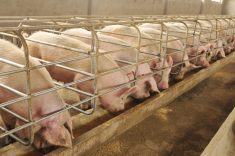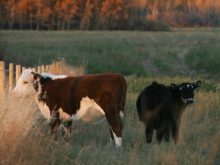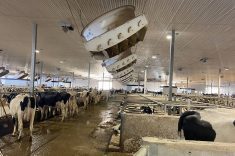SUNDRE, Alta. – Knowing how to properly assess a cow’s condition is a good tool for balancing winter feed rations, says an Alberta Agriculture beef specialist.
Cows may look fatter than they really are so feeding programs should be adjusted to ensure they stay healthy, said Trevor Yurchak at a producer workshop near Sundre.
The Canadian condition score is based on a scale of one to five with three being the ideal for a beef cow. It is done by feeling the fat cover on the short ribs along the middle of the cow’s back.
Read Also

VIDEO: British company Antler Bio brings epigenetics to dairy farms
British company Antler Bio is bringing epigenetics to dairy farms using blood tests help tie how management is meeting the genetic potential of the animals.
A government study from 1997-2000 looked at fat, moderate and thin cow performance.
Thinner cows had more calving difficulty and produced less colostrum.
A thin cow with a condition score of two or less produces a litre of colostrum in a 64 minute interval. A cow with a moderate condition score of three produces 1.7 litres of colostrum within 35 minutes.
The calves with thin mothers receive fewer antibodies through mother’s milk.
“We’re no longer saying you need more cows to make a living. You need better cows,” he said.
Using National Research Council recommendations for feeding cattle, the study found it was difficult to bulk up the thin ones.
“Based on NRC, thin cows take a whole lot more energy to build condition than even we had guessed,” he said.
The fat ones should have lost weight but retained their weight based on NRC feeding recommendations. However, the study found fattened cows cost less to feed over the winter.
Thin cows that were grazed too long, pushed too hard on pasture or kept their calves too long cost $1.18 per day to feed. The fat cows or those with good pasture cost 66 cents a day to feed.
Yurchak is a proponent of earlier weaning. It gives the cow more time to recover for rebreeding and gain weight to carry through the winter.
“Wean at 120-150 days of age. You get better conditioned cows and your calves will do way better in performance,” he said.
Studies of calf feed intake showed they manage well on regular feed early in life.
A 200 pound calf gets 40 percent of its nutritional requirements from mother’s milk. A six-month-old calf weighing 540 lb. gets between seven and 15 percent of its requirements from the dam.
“All that is, is a very expensive babysitting service because the calf isn’t getting anything but the cow is brutally being run down.”

















